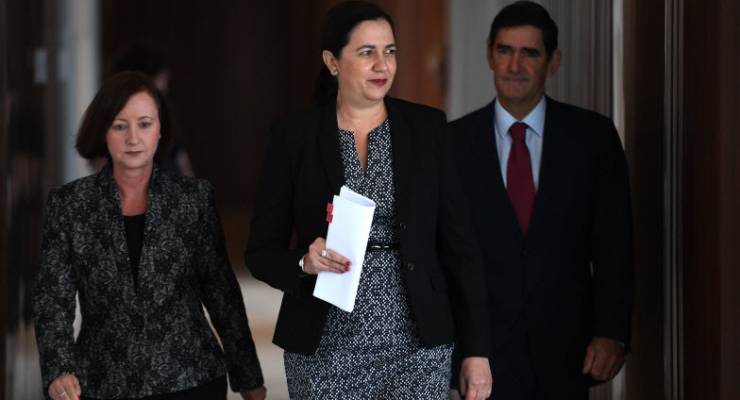
With the publication of proposed new electoral boundaries last Friday, the scene is set in Queensland for the most fascinating state election Australia has seen since One Nation scored 11 seats there in 1998.
Ever since the shock defeat of Campbell Newman’s LNP government in January 2015, Labor, under Annastacia Palaszczuk, has been clinging precariously to power, with the parliamentary numbers currently sitting at Labor 42, Liberal National Party 41, independents three, Katter’s Australian Party (KAP) two and One Nation one.
Reflecting the rural orientation of much of the crossbench, the government has been unable to carry the day on votes relating to matters including tree-clearing, sugar industry regulation and gun laws.
It has also been in the position (familiar to Julia Gillard) of depending for its survival on a supposedly “tainted vote” from Cape York Peninsula MP Billy Gordon, who was expelled from Labor shortly after the election for failing to disclose criminal convictions, and has lately faced contempt of parliament proceedings.
With the growing unpopularity of the Turnbull government providing dead weight for the conservative cause across the country, and voters failing to warm to new-ish Opposition Leader Tim Nicholls, it is widely anticipated that Palaszczuk will take the last ever opportunity to roll the dice early before the state’s new regime of fixed four-year terms takes effect.
By some earlier accounts, the happy day loomed as early as next month.
However, Palaszczuk told the media last week that her government would “fight the next election on the boundaries that are presented to us”.
Taking into account the process of finalising the redistribution and the minimum allowable election campaign period, that means the earliest possible date is in mid-July, with informed speculation favouring October or November.
The new boundaries give effect to one of several electoral law developments since the last election (four-year terms being another), which, in this case, transpired against the wishes of the minority government.
This was an increase in the size of Parliament — a move seemingly favoured by nobody but country MPs, who have come to live in fear of having their seats abolished to make room for new ones in the growing cities (Western Australia’s Nationals introduced a similar measure to Parliament last year, which failed to win support from the Liberals).
Since the crossbench is dominated by rationally self-interested regional MPs, the opposition was able to find the votes to win the support of the Parliament, if not the electorate, and in doing so to subject the government to defeat over a bill of the foremost importance.
[Poll Bludger: Hansonism is a more potent force than Katterism or Palmerism]
Under the draft proposal, the number of seats in the stagnant regions has duly been preserved (though this hasn’t stopped KAP MP Shane Knuth from waxing conspiratorial about the dramatic redrawing of his seat in the state’s north), and new ones are to be created on the Gold Coast, the Sunshine Coast and in Ipswich.
Brisbane is to be re-ordered so that a seat near the city will be abolished, and new ones will be created on the northern and southern fringes.
According to Antony Green’s calculations, the changes are slightly to the advantage of Labor in that three of the five new seats would have been won by them based on 2015 election results, and the abolished seat of Indooroopilly is a generally safe conservative seat held by shadow treasurer Scott Emerson.
However, the utility of projections based on the last election stands to be sorely tested by the disruptive force that is One Nation.
While the LNP is — for now at least — rejecting the notion of a post-election power-sharing arrangement, there can be little doubt that thoughts of a preference deal loom large in its electoral calculations.
[Poll Bludger: Barnett’s One Nation deal might have just handed Labor 5 seats]
In particular, the LNP will be hoping that Labor’s sneaky move to reintroduce compulsory preferential voting through an amendment to the bill that increased the size of parliament will prove to have been a spectacular own goal.
Whereas One Nation might otherwise have had the effect of splitting the anti-Labor vote and ensuring a return to the dominance Labor enjoyed in the Peter Beattie days, the LNP can now hope the party will serve as a right-of-centre counterpoint to the Greens.
That’s assuming One Nation voters are of a mind to be guided by a preference deal with the Coalition parties — something that has never really been put to the test at an election held under compulsory preferential voting.
Some insight into the reality of that will be provided when One Nation voters in Western Australia size up their how-to-vote cards and fill out their ballot papers in just under a fortnight’s time.








I’m predicting a ‘Limited News Party/One Nation coalition’ – for 4 years (with the new term) – thanks again Annastacia…..at least their internal bun fighting will be amusing.
And the new premier of Queensland would be . . ? What news of the redhead resigning from the Senate to run in the state election (after all, she could win more or less any seat she ran in). We ain’t seen nothin’ yet.
Neil Symes …..?
Please stop, you are scaring me.
And it might give her the idea. If she did resign her Senate seat it would devolve down the list so the PHONies would remain 3 or 4 depending on the Culleton fall-out and stronger when, not if she swept into government in Brisbane.
Serves Palaszczuk right. She’s forgotten which party and which set of values she holds! Stupid woman!